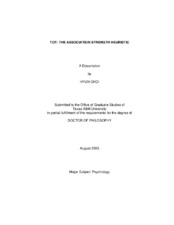| dc.contributor.advisor | Smith, Steven M. | |
| dc.creator | Choi, Hyun | |
| dc.date.accessioned | 2005-11-01T15:47:50Z | |
| dc.date.available | 2005-11-01T15:47:50Z | |
| dc.date.created | 2005-08 | |
| dc.date.issued | 2005-11-01 | |
| dc.identifier.uri | https://hdl.handle.net/1969.1/2629 | |
| dc.description.abstract | Three experiments were conducted to examine the effect of association strength on TOT (tip-of-the-tongue states) and recall. Two hundred nineteen undergraduate students studied pictures and names of 24 imaginary animals that were presented on a large computer screen. The strength of association between the cue and target was manipulated by varying the number of times the picture and the name were presented simultaneously, while keeping the number of presentations for each picture or the target constant across conditions. After the study phase, participants were cued by each picture to recall the imaginary animal names. Participants were asked to rate their strength of TOT on a scale ranging 0 to 3 for each item if they could not think of the name at the moment. Participants also made subjective judgments as to how many times they saw the picture and name of the animal co-occur on the same screen at the study phase, and then they performed a recognition test at the end. The results indicated that the frequency and strength of TOTs linearly increased as a function of number of co-occurrences; the correlation between TOT strength and the participants??
subjective estimation of number of co-occurrences was greater than the correlation between TOT strength and the actual number of co-occurrences. This pattern of results was found even when recall increased along with the increase in number of co-occurrences and was more pronounced particularly when recall was reduced either by interference (Experiment 1) or by increased number of critical items (Experiments 2 & 3) and also by a reduced number of co-occurrence conditions and an increased gap between one level to the next (Experiment 3). Results suggest that an increase in association strength concomitantly increases TOT strength especially when the activation of the target is under threshold for recall and that people may use rules of thumb, or heuristic when they report TOTs by estimating the strength of the cue-target association. | en |
| dc.format.extent | 986190 bytes | en |
| dc.format.medium | electronic | en |
| dc.format.mimetype | application/pdf | |
| dc.language.iso | en_US | |
| dc.publisher | Texas A&M University | |
| dc.subject | TOT State | en |
| dc.subject | Tip-of-the-tongue | en |
| dc.subject | memory | en |
| dc.subject | association strength | en |
| dc.subject | co-occurrence | en |
| dc.title | TOT: the association strength heuristic | en |
| dc.type | Book | en |
| dc.type | Thesis | en |
| thesis.degree.department | Psychology | en |
| thesis.degree.discipline | Psychology | en |
| thesis.degree.grantor | Texas A&M University | en |
| thesis.degree.name | Doctor of Philosophy | en |
| thesis.degree.level | Doctoral | en |
| dc.contributor.committeeMember | Shea, Charles | |
| dc.contributor.committeeMember | Vaid, Jyotsna | |
| dc.contributor.committeeMember | Yamauchi, Takashi | |
| dc.type.genre | Electronic Dissertation | en |
| dc.type.material | text | en |
| dc.format.digitalOrigin | born digital | en |


